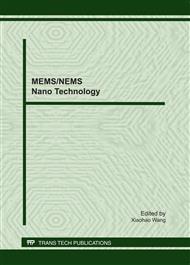p.674
p.679
p.684
p.690
p.694
p.699
p.705
p.711
p.716
Analysis of Capillary Condensation of Vapor in Multi-Wall Carbon Nanotubes
Abstract:
Multi-wall Carbon Nanotubes (MWNTs) is the new hotspot material as the active sensing element, but there is no certain theory on the phenomenon of the vapor's capillary condensation in MWNTs for the present. This paper presents a new theory that the capillary condensation of vapor in MWNTs mostly occur in the internal hollow tube, according to the calculation of equivalent model of MWNTs. A kind of carbon nanotubes (CNTs) humidity sensor based on quartz crystal microbalance was fabricated, CNTs employed as adsorption materials. The sensor was put in 11% and 97% relative humidity environment in experimental, and the value of MH2O/MCNT was calculated. The theory in this paper is proved by the comparison between the experimental and the analysis results.
Info:
Periodical:
Pages:
694-698
Citation:
Online since:
June 2011
Authors:
Price:
Сopyright:
© 2011 Trans Tech Publications Ltd. All Rights Reserved
Share:
Citation:


